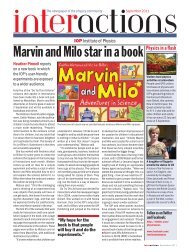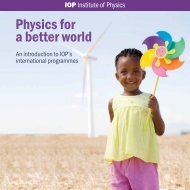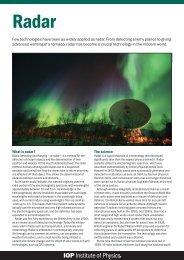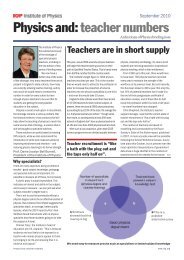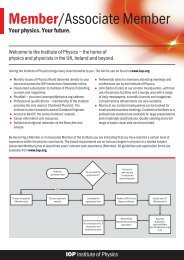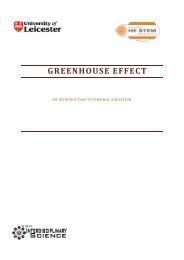Girls in the Physics Classroom: A Teachers' Guide - Institute of Physics
Girls in the Physics Classroom: A Teachers' Guide - Institute of Physics
Girls in the Physics Classroom: A Teachers' Guide - Institute of Physics
Create successful ePaper yourself
Turn your PDF publications into a flip-book with our unique Google optimized e-Paper software.
2: Lessons from research<br />
Table 2.6: Teacher questionnaire<br />
The questions ask you (i) whe<strong>the</strong>r you believe some behaviours are more typical <strong>of</strong> girls than boys, and vice versa; and (ii) whe<strong>the</strong>r girls and boys<br />
differ <strong>in</strong> how well <strong>the</strong>y do <strong>in</strong> physics. Circle <strong>the</strong> extent to which you agree with <strong>the</strong> follow<strong>in</strong>g statements. If you feel that girls and boys are equally good<br />
or poor <strong>in</strong> a particular respect, circle <strong>the</strong> positive or negative end <strong>of</strong> <strong>the</strong> scale for both; differences <strong>in</strong> behaviours should show up <strong>in</strong> <strong>the</strong> difference<br />
between <strong>the</strong> scores.<br />
Behaviour <strong>Girls</strong> Boys<br />
Which students: very not at all very not at all<br />
answer questions <strong>in</strong> whole class sessions? 1 2 3 4 5 1 2 3 4 5<br />
f<strong>in</strong>d physics <strong>in</strong>terest<strong>in</strong>g? 1 2 3 4 5 1 2 3 4 5<br />
do <strong>the</strong> best coursework? 1 2 3 4 5 1 2 3 4 5<br />
are <strong>the</strong> most confident <strong>in</strong> discussion? 1 2 3 4 5 1 2 3 4 5<br />
are <strong>the</strong> most diligent <strong>in</strong> do<strong>in</strong>g homework? 1 2 3 4 5 1 2 3 4 5<br />
enjoy physics? 1 2 3 4 5 1 2 3 4 5<br />
tend to do <strong>the</strong> writ<strong>in</strong>g up carefully? 1 2 3 4 5 1 2 3 4 5<br />
f<strong>in</strong>d physics easy? 1 2 3 4 5 1 2 3 4 5<br />
ask for help <strong>in</strong> practical work? 1 2 3 4 5 1 2 3 4 5<br />
are likely to want to cont<strong>in</strong>ue with physics? 1 2 3 4 5 1 2 3 4 5<br />
example, you might select <strong>the</strong> <strong>in</strong>troduction and starter activity<br />
and <strong>the</strong> plenary if you are <strong>in</strong>terested <strong>in</strong> feedback <strong>in</strong> a<br />
whole-class situation. You might <strong>in</strong> one observation session<br />
focus ma<strong>in</strong>ly on <strong>the</strong> question<strong>in</strong>g technique:<br />
● Are students selected to answer questions?<br />
● Who has <strong>the</strong>ir hands up?<br />
● Which students are asked questions by selection or<br />
because <strong>the</strong>ir hands are up? Check if it is a girl or a boy<br />
and how many times any <strong>in</strong>dividual student is asked.<br />
● Are <strong>the</strong>re students who had <strong>the</strong>ir hands up but gave up?<br />
● Which students are not <strong>in</strong>volved <strong>in</strong> <strong>the</strong> question-andanswer<br />
sessions?<br />
Teacher feedback<br />
In ano<strong>the</strong>r session you might want to consider <strong>the</strong> type <strong>of</strong><br />
feedback given. This could <strong>in</strong>volve observ<strong>in</strong>g whole-class<br />
question-and-answer sessions where you consider:<br />
● What types <strong>of</strong> question are asked <strong>of</strong> which students?<br />
● How long are students given to respond?<br />
● What k<strong>in</strong>ds <strong>of</strong> feedback are students receiv<strong>in</strong>g – th<strong>in</strong>k<br />
<strong>of</strong> <strong>the</strong> length <strong>of</strong> <strong>the</strong> <strong>in</strong>teraction, content and purpose.<br />
To extend this exercise, you could observe a few groups<br />
<strong>of</strong> students as <strong>the</strong>y cont<strong>in</strong>ue with <strong>the</strong>ir work. Focus on <strong>the</strong><br />
teacher–student <strong>in</strong>teractions. Consider:<br />
● which students seek help;<br />
● which students don’t;<br />
● what k<strong>in</strong>d <strong>of</strong> help <strong>the</strong>y seek;<br />
● what k<strong>in</strong>d <strong>of</strong> <strong>in</strong>teraction follows – note <strong>the</strong> content and<br />
purpose <strong>of</strong> <strong>the</strong> <strong>in</strong>teraction;<br />
● which students are challenged to reflect on <strong>the</strong>ir<br />
th<strong>in</strong>k<strong>in</strong>g and take responsibility for <strong>the</strong> next step;<br />
● which students are told what to do – note whe<strong>the</strong>r girls<br />
or boys are <strong>in</strong>volved <strong>in</strong> each type <strong>of</strong> <strong>in</strong>teraction;<br />
● which students <strong>the</strong> teacher chooses to <strong>in</strong>teract with –<br />
is this about <strong>the</strong>ir work or <strong>the</strong>ir behaviour?<br />
Collaboration between students<br />
You could use observation as a way <strong>of</strong> <strong>in</strong>vestigat<strong>in</strong>g students’<br />
approaches to learn<strong>in</strong>g. Feedback from <strong>the</strong> questionnaire<br />
about what makes a good physics teacher may<br />
provide <strong>in</strong>sights <strong>in</strong>to which students valued discussion and<br />
collaboration. When students are set <strong>in</strong>dividual tasks, leave<br />
a tape recorder record<strong>in</strong>g on tables with ei<strong>the</strong>r mixed or s<strong>in</strong>gle-sex<br />
groups. Record 10–15 m<strong>in</strong>utes <strong>of</strong> <strong>the</strong> session.<br />
● Which students tend to talk toge<strong>the</strong>r?<br />
● Which students discuss <strong>the</strong>ir work dur<strong>in</strong>g <strong>the</strong>ir talk?<br />
● Do some students talk out loud about <strong>the</strong>ir work as<br />
<strong>the</strong>y attempt it? Are <strong>the</strong>y girls and boys or ma<strong>in</strong>ly girls?<br />
● Is <strong>the</strong>re more collaboration on tasks <strong>in</strong> s<strong>in</strong>gle-sex<br />
groups? Is this <strong>the</strong> case for girls and boys?<br />
2.3b Tak<strong>in</strong>g action<br />
The feedback from <strong>the</strong> activities will provide you with <strong>in</strong>formation<br />
to reflect on your practice. You might want to try<br />
some <strong>in</strong>terventions to change practice.<br />
Encourag<strong>in</strong>g collaboration<br />
Some practices, such as organis<strong>in</strong>g more group work, need<br />
to pay attention to <strong>the</strong> roles that different students tend to<br />
avoid or embrace. Advice given <strong>in</strong> sections 2.2 and 2.4<br />
(“Tak<strong>in</strong>g action”) will help here. Your observations will have<br />
<strong>in</strong>dicated which students tend to collaborate and which<br />
avoid it. You might usefully discuss with <strong>the</strong> class, or let<br />
groups discuss toge<strong>the</strong>r, <strong>the</strong> rules needed to ensure collaboration.<br />
These will <strong>in</strong>clude:<br />
● listen<strong>in</strong>g carefully to one ano<strong>the</strong>r;<br />
18 I NSTITUTE OF P HYSICS R EPORT G IRLS IN THE P HYSICS C LASSROOM: A TEACHERS’ GUIDE FOR A CTION D ECEMBER 2006






